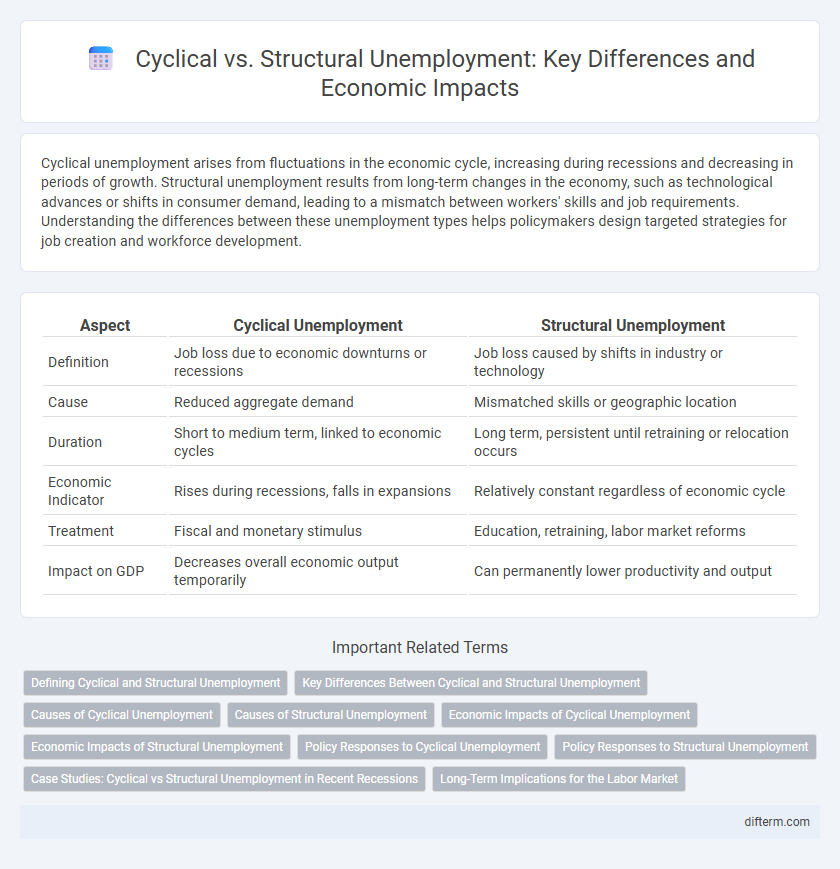Cyclical unemployment arises from fluctuations in the economic cycle, increasing during recessions and decreasing in periods of growth. Structural unemployment results from long-term changes in the economy, such as technological advances or shifts in consumer demand, leading to a mismatch between workers' skills and job requirements. Understanding the differences between these unemployment types helps policymakers design targeted strategies for job creation and workforce development.
Table of Comparison
| Aspect | Cyclical Unemployment | Structural Unemployment |
|---|---|---|
| Definition | Job loss due to economic downturns or recessions | Job loss caused by shifts in industry or technology |
| Cause | Reduced aggregate demand | Mismatched skills or geographic location |
| Duration | Short to medium term, linked to economic cycles | Long term, persistent until retraining or relocation occurs |
| Economic Indicator | Rises during recessions, falls in expansions | Relatively constant regardless of economic cycle |
| Treatment | Fiscal and monetary stimulus | Education, retraining, labor market reforms |
| Impact on GDP | Decreases overall economic output temporarily | Can permanently lower productivity and output |
Defining Cyclical and Structural Unemployment
Cyclical unemployment arises from fluctuations in the business cycle, increasing during economic downturns when demand for goods and services declines. Structural unemployment occurs due to mismatches between workers' skills and job requirements, often caused by technological advancements or shifts in industry composition. Understanding the distinction between these types is crucial for designing targeted economic policies to foster labor market stability.
Key Differences Between Cyclical and Structural Unemployment
Cyclical unemployment arises from fluctuations in the economic cycle, where demand for goods and services falls during recessions, leading to temporary job losses. Structural unemployment results from fundamental shifts in the economy, such as technological advancements or changes in consumer preferences, causing a mismatch between worker skills and job requirements. The key difference lies in duration and cause: cyclical unemployment is temporary and linked to economic downturns, while structural unemployment is long-term and tied to structural changes in the labor market.
Causes of Cyclical Unemployment
Cyclical unemployment arises primarily from fluctuations in economic activity, where a downturn or recession leads to decreased demand for goods and services, causing businesses to reduce their workforce. This type of unemployment is closely linked to the business cycle phases, with job losses increasing during contractions and decreasing during expansions. Unlike structural unemployment, cyclical unemployment is temporary and can be mitigated through fiscal stimulus and monetary policies aimed at boosting aggregate demand.
Causes of Structural Unemployment
Structural unemployment arises primarily from fundamental shifts in an economy's structure, such as technological advancements, globalization, and changes in consumer preferences that render certain skills obsolete. This type of unemployment is caused by mismatches between workers' skills and the demands of evolving industries, inadequate education or training systems, and geographic immobility. Unlike cyclical unemployment, which fluctuates with the business cycle, structural unemployment tends to be long-term and requires targeted policy interventions like retraining programs and education reform to address skill gaps.
Economic Impacts of Cyclical Unemployment
Cyclical unemployment rises during economic downturns when aggregate demand falls, leading to reduced production and widespread job losses across industries. This unemployment type results in decreased consumer spending, which further contracts economic growth and can prolong recessions. Governments often respond with fiscal and monetary policies aimed at stimulating demand to mitigate these economic impacts.
Economic Impacts of Structural Unemployment
Structural unemployment causes long-term economic inefficiencies by creating skill mismatches in the labor market, which reduce overall productivity and hinder economic growth. This type of unemployment leads to higher social costs, including increased government spending on unemployment benefits and retraining programs. Persistent structural unemployment also depresses consumer spending, exacerbating slow economic recovery and widening income inequality.
Policy Responses to Cyclical Unemployment
Policy responses to cyclical unemployment primarily involve fiscal stimulus measures such as increased government spending and tax cuts designed to boost aggregate demand and revive economic activity. Central banks may implement monetary policies like lowering interest rates to encourage investment and consumer spending, thereby reducing joblessness during economic downturns. These counter-cyclical strategies aim to shorten recessions and stabilize employment, distinguishing cyclical unemployment from structural unemployment, which requires different, long-term solutions.
Policy Responses to Structural Unemployment
Policy responses to structural unemployment emphasize investment in education, retraining programs, and skill development to align the workforce with evolving industry demands. Government incentives for innovation and infrastructure projects stimulate job creation in emerging sectors, mitigating long-term unemployment caused by structural shifts. Labor market reforms, including improved job matching services and mobility support, enhance workforce adaptability and reduce structural employment gaps.
Case Studies: Cyclical vs Structural Unemployment in Recent Recessions
Recent recessions highlight cyclical unemployment through sharp spikes in joblessness tied to economic downturns, such as the 2008 financial crisis, where demand shocks led to temporary layoffs in manufacturing and services. Structural unemployment, exemplified by the decline of coal mining regions during the same period, reflects long-term mismatches between workers' skills and evolving industry needs. These case studies underscore the importance of targeted retraining programs and proactive fiscal policies to address differing unemployment dynamics.
Long-Term Implications for the Labor Market
Cyclical unemployment fluctuates with economic downturns and typically subsides as demand recovers, presenting mostly short-term challenges for the labor market. Structural unemployment results from fundamental shifts in the economy, such as technological advancements or industry decline, causing prolonged joblessness and requiring comprehensive workforce retraining and education. Long-term structural unemployment can lead to skill mismatches, decreased labor force participation, and persistent inefficiencies, impacting overall economic growth and labor market adaptability.
Cyclical unemployment vs Structural unemployment Infographic

 difterm.com
difterm.com